Green pufferfish - Tetraodon fluviatilis
Scientific name: Tetraodon fluviatilis
Common name: Green pufferfish
Family: Tetraodontidae
Usual size in fish tanks: 15 - 17 cm (5.91 - 6.69 inch)
014
Recommended pH range: 5.9 - 7.5
Recommended water hardness: 5 - 20°N (89.29 - 357.14ppm)
0°C 32°F30°C 86°F
Recommended temperature range: 23 - 27 °C (73.4 - 80.6°F)
The way how these fish reproduce: Spawning
Where the species comes from: South Asia
Temperament to its own species: aggressive/territorial
Temperament toward other fish species: aggressive/territorial
Usual place in the tank: Middle levels
Origin
Tetraodon fluviatilis, commonly known as the green pufferfish, is native to brackish and freshwater estuaries, rivers, and coastal zones across South and Southeast Asia. Their natural distribution includes countries such as India, Bangladesh, Sri Lanka, Cambodia, Myanmar, and Thailand. They are often found in mangrove swamps, tidal rivers, and lowland streams, where salinity levels fluctuate with tidal flow.
Short description
The green pufferfish belongs to the family Tetraodontidae and is known for its unique appearance and behavior. Adult specimens reach an average size of 15–17 cm (6–6.7 inches) and require spacious tanks due to their high activity level. These fish are aggressive and territorial, especially toward their own kind. They are best housed alone or with other robust brackish species such as scats or archerfish.
They have evolved the ability to inflate themselves up to three times their size by taking in water or air—a defense mechanism against predators. This inflation may also occur without any apparent threat. Another curious feature is their ability to blink, which is unique among fish.
Their fused teeth form a beak-like structure used to crush the shells of crustaceans and mollusks. This beak grows continuously and must be worn down through feeding on hard-shelled food.
Green pufferfish carry tetrodotoxin, a potent neurotoxin with no known antidote. While they are not dangerous to touch in the aquarium, ingestion of this toxin is lethal—extreme caution is advised when handling them or cleaning tanks.
Lifespan
With proper care, green pufferfish can live up to 15 years in captivity.
General care
The minimum tank size should be 120 cm (4 feet) in length and at least 30 cm (12 inches) in width. While juveniles tolerate freshwater, adults must be kept in brackish water. Maintain a specific gravity (SG) of around 1.010–1.015 to simulate their natural habitat. The recommended temperature is 23–27°C (73.4–80.6°F), with a pH range of 5.9–7.5 and water hardness of 5–20 dGH.
Use soft sand as substrate, and provide driftwood, stones, or rockwork for hiding spots. Live plants may not thrive in brackish setups, so use only very hardy species or opt for artificial plants.
These fish produce significant waste, so a powerful filtration system is essential. Supplement this with weekly water changes of 10–20% to maintain water quality and reduce nitrate buildup.
Feeding
Green pufferfish are strict carnivores. Their diet should include live or frozen snails, shellfish (with shells), and small crustaceans to maintain beak health. Occasional treats like chopped earthworms or frozen shrimp are also appreciated. Avoid flake food or soft pellets, as they do not help wear down their beaks.
Sexing
There are no visible external differences between male and female green pufferfish.
Breeding
Breeding in captivity is rare and not well documented. In the wild, males build circular nests in the sand, stirring the substrate to attract females. After spawning, females leave the nest, and males may spawn with other females in the area. The male is solely responsible for guarding and tending to the eggs until they hatch.



 Red
Red  Striped
Striped  Malabar
Malabar  Amazon
Amazon  Red-spot
Red-spot  Bailey’s
Bailey’s  Thai
Thai  Figure
Figure  Fang’s
Fang’s  Coral
Coral  Giant
Giant  Congo
Congo  Green
Green  Humpback
Humpback  Mekong
Mekong  Bronze
Bronze